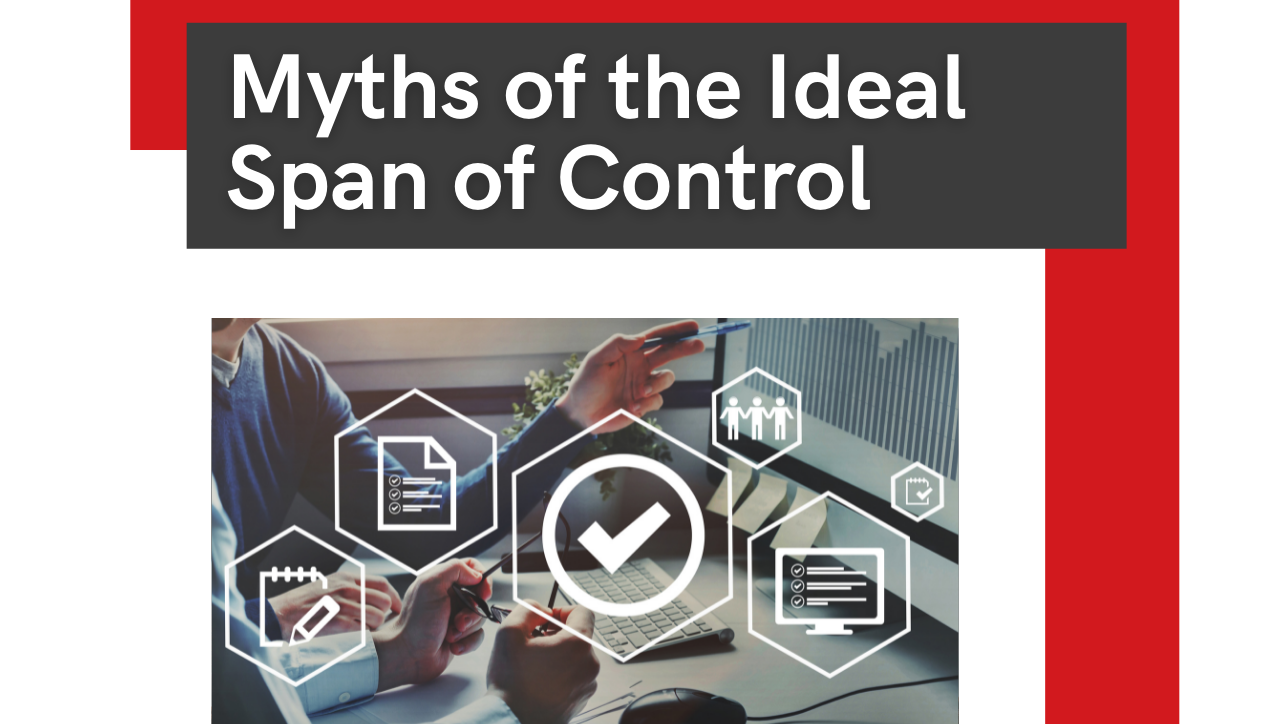4 Minute Read
Takeaway: We are often asked what the ideal span of control is. There are many myths about the ideal span of control, our answer is that there is no such thing as an ideal because ‘It depends’.
Spans of control are a function of several components, so there is no easy answer to the question. However, the clue lies in its name, spans of CONTROL. Remember that this is about controlling work and decisions and not controlling people. The initial thinking about a span of control decision is done in the ‘Foundation’ phase of your operating model design work and plays out in ‘Detailed Design’. It should be alluded to in your design criteria but is not laid down as a hard number at this point.
Although there are no hard and fast rules about what spans of control should be, there are some indicators that guide the design thinking;
- The greater the level of control that is needed over the work, the more time managers/leaders spend on controlling activities and making operational decisions, therefore there are narrower spans of control.
- Regulated industries generally need greater levels of control in order to comply with external requirements and constraints. This often results in more layers of management in control and operational decision-making roles with narrower spans of control. I.e. They are controlling in specialist areas. We see this in the Nuclear industry, in banking, in Health, etc.
- The closer you push decision making to the customer and the day- to-daywork (The frontline), the greater the spans of control can be because the decision-making and control of the day-to-day operation are done by frontline teams.
- The greater your work is standardised, the greater your spans of control, as Standard Operating Procedures do your controlling for you.
- The more you use technology to error check, manage workflow and identify variances, the greater your spans of control can be, as managers are not needed to do the controlling.
- I could go on …
All of the above are about controlling the work, this is primarily what managers do through the people they ‘manage’ – managers are fundamentally a horizontal coordinating mechanism. Because of the above and the decisions that are made when setting the design criteria, parameters and constraints for the business’ operating model, a manager’s span of control can vary from a handful in a highly controlled specialist area, to large numbers when work is done by multidisciplinary teams with decision making power.
The role of Managers
Managers are a horizontal coordination mechanism that ensures that work flows quickly, error-free, and to plan from end-to-end in the value stream – they have an operational focus within a defined time span of discretion.
The role of Directors/Senior Leaders
Directors/Senior leaders have a different role, they are part of a vertical coordinating mechanism, they have a strategic role with a longer time span of discretion. Thus, they are an integration point for the managers they direct (Not control). Their primary role is both to co-ordinate the mechanisms that determine the ‘functional’ strategy that their managers will use to develop plans and be part of the mechanism that sets the business strategy and plans that inform their ‘functional’ strategy.
Shape – The Ship’s Decanter.
 Coming back to the question of how many direct reports to the CEO, and then how many to the CEO’s direct reports? The answer lies in how specialised you need the voices to be in the business-level strategic decision-making mechanism, this normally determines how many reports a CEO has, (some CEO’s decide to have two mechanisms; a strategic board with their direct reports and an operational board which may include others from layers below).
Coming back to the question of how many direct reports to the CEO, and then how many to the CEO’s direct reports? The answer lies in how specialised you need the voices to be in the business-level strategic decision-making mechanism, this normally determines how many reports a CEO has, (some CEO’s decide to have two mechanisms; a strategic board with their direct reports and an operational board which may include others from layers below).
Very ‘traditional’ organisations often default to a functional structure where every function has a director, and they all report to the CEO. However, this traditional model is losing favour with CEOs moving to have a smaller number of direct reports that have blended/mixed portfolios where they are expected to integrate across ‘functions’, with one or two specialists who are the voice of the core competence of the business.
Perhaps you saw the recent BBC piece about Octopus Energy who has no HR or IT Department/Director? This does not mean that this work does not have a voice at the strategic table, just that one or more people will be the integration point as part of a broader portfolio. Where this is leading is to what I think of as a ‘Ship’s Decanter’ shape (As opposed to the traditional pyramid) where the CEO has a small number of reports, these reports then have a larger number of reports as their role is to integrate across work areas/functions. As you move into the management layers the spans of control get quite large in a flatter organisation with dispersed management and decision making.
So, in summary, there is no straightforward answer to the spans of control question, deciding is part of a much more holistic design and decision-making process.
Learn more about how OTM’s Organisation Design Solution can help bring effective change to your company.
Peter Turgoose is a Senior Consultant at ON THE MARK.
OTM is the leading global boutique organization design consultancy with offices in the USA and UK. With over 450 successful redesigns and operating model modernizations completed, OTM is owner of the industry’s most integrated, comprehensive and holistic organization design solution. OTM enables its clients to realize their future ambitions.


